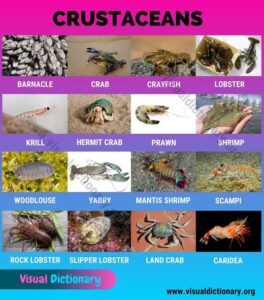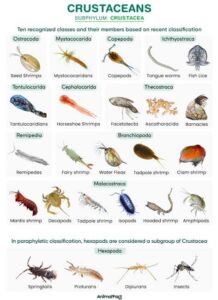Back to: ZOOLOGY 200 Level
WELCOME TO CLASS
Today, we’re going to look at some real-life examples of crustaceans—crabs, shrimps, and barnacles. These animals are not just common in our rivers, oceans, and even markets—they also show us how wonderfully diverse and adapted the invertebrate world is. Let’s take a closer look at each of them and understand what makes them special.
Examples: Crabs, Shrimps, Barnacles
Crabs: the armoured crawlers
Crabs are perhaps the most recognised crustaceans, known for their broad, flat bodies and strong claws. They have a hard exoskeleton that protects them, and they walk sideways using their jointed legs. Crabs have five pairs of legs, with the first pair modified into powerful pincers used for catching food and fighting off threats.

You’ll often see crabs along the shorelines or in tidal pools, digging into the sand or hiding under rocks. In Nigerian coastal communities, crabs are also a delicacy, adding both nutritional and economic value.
Shrimps: the agile swimmers
Shrimps are slender, soft-bodied crustaceans with long antennae and a flexible abdomen. Unlike crabs, they are excellent swimmers, using their abdominal muscles and tail fan to propel themselves through water. They have ten legs and are often found in both freshwater and saltwater environments.
Shrimps are very important both ecologically and economically. In the ecosystem, they serve as food for fish, birds, and larger marine animals. In local markets, they are a source of income and are enjoyed in dishes such as seafood pepper soup and fried rice.

Barnacles: the fixed survivors
Barnacles are unique among crustaceans because they don’t move around. Instead, they attach themselves permanently to hard surfaces like rocks, boat hulls, and even whales! Though they look like tiny shells, barnacles are related to crabs and shrimps. As adults, they use feather-like appendages called cirri to filter food from the water.
Barnacles are important because they form part of the marine food web, and their presence can also tell scientists about water quality and marine health.
Summary
- Crabs have flat bodies and strong claws, walk sideways, and are commonly found in coastal areas.
- Shrimps are agile swimmers with soft bodies, long antennae, and play major roles in ecosystems and economies.
- Barnacles are sessile crustaceans that stick to hard surfaces and feed by filtering water with cirri.
- These examples show the variety in structure, behaviour, and habitat among crustaceans.
Evaluation
- Mention one key difference between crabs and shrimps.
- What structure do barnacles use for feeding?
- How do shrimps move in water?
- List one ecological and one economic importance of shrimps.
Every lesson takes you one step closer to mastering Zoology and understanding the world around you. You’re doing so well—Afrilearn is proud to be part of your journey. Ready for the next discovery? Let’s go!
